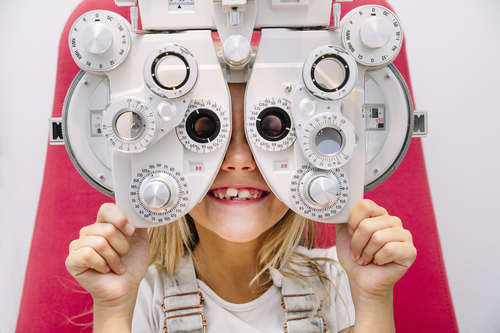Checking Out the current Technical Improvements in Optometry and What They Mean for Optometrists
In the ever-evolving area of optometry, current technical developments are improving exactly how experts come close to eye care. From the accuracy of Optical Coherence Tomography to the nuanced insights used by AI-driven analysis devices, these developments are setting new requirements in client evaluation and treatment. Teleoptometry is poised to redefine availability, making certain that proficiency goes beyond geographical constraints. As these developments permeate the technique, eye doctors are confronted with the difficulty of embracing these tools to enhance patient results. The question stays: just how will these technological changes redefine the roles and obligations within the career?
Technologies in Diagnostic Devices
Progressing the area of optometry, innovations in diagnostic devices have actually transformed the way eye treatment specialists analyze and diagnose aesthetic problems and eye problems. The previous years has actually witnessed significant technological advancements, allowing more detailed and accurate evaluations. Optical Comprehensibility Tomography (OCT), for instance, supplies high-resolution cross-sectional photos of the retina, allowing for the early discovery of conditions such as glaucoma and age-related macular degeneration. This non-invasive imaging technique has actually ended up being important in contemporary optometric practice.
One more secret development is the intro of advanced corneal topography systems, which map the surface curvature of the cornea with accuracy. These devices are specifically valuable for fitting get in touch with lenses and detecting corneal conditions. Furthermore, digital retinal imaging has actually transformed standard ophthalmoscopy, offering comprehensive, breathtaking views of the retina that assist in thorough visual assessments.
The growth of wavefront aberrometry has actually additionally been crucial, allowing the evaluation of refractive mistakes with unparalleled accuracy (Eye Doctor). This modern technology assists in personalizing rehabilitative lenses and boosting surgical results for refractive surgeries. Collectively, these analysis innovations empower optometrists to deliver superior client care, making certain very early treatment and customized therapy approaches, inevitably enhancing aesthetic wellness end results
AI in Person Administration
Structure on the foundation of advanced diagnostic tools, the unification of man-made intelligence (AI) in person monitoring represents a transformative leap for optometry. AI systems are significantly utilized to improve performance, accuracy, and personalization in person care.
Moreover, AI-driven systems facilitate streamlined patient communications and management processes. Automated organizing, digital examinations, and personalized follow-up plans not just enhance individual complete satisfaction but also enhance time monitoring for specialists. These systems can triage people based on the seriousness of their problems, ensuring that those in vital demand receive timely interest.
In addition, AI enhances decision-making by providing optometrists with evidence-based referrals and therapy pathways. By incorporating information from electronic health and wellness documents, AI devices offer insights that inform scientific choices, decreasing the threat of errors and improving client end results. As AI continues to evolve, its role in client monitoring will likely increase, improving the landscape of optometric treatment.
Advancements in Retinal Imaging
In the world of optometry, retinal imaging has actually observed impressive technical developments that are improving diagnostic abilities and client treatment. Technologies such as Optical Comprehensibility Tomography (OCT) and fundus photography have revolutionized just how eye doctors examine the retina and envision. OCT, in particular, offers high-resolution, cross-sectional pictures of the retina, enabling for the in-depth assessment of its layers. This capacity is invaluable for very early discovery and administration of conditions like glaucoma, diabetic person retinopathy, and age-related macular deterioration.
Boosted imaging modalities like OCT angiography are more refining diagnostic accuracy. This non-invasive technique maps blood circulation in the retina, using vital insights into vascular health without the requirement for dye shots. Additionally, flexible optics innovation is being integrated right into retinal imaging systems to fix eye aberrations, providing unmatched photo clearness. Such innovations help with the identification of min retinal adjustments that can signify illness development.
Furthermore, improvements in fabricated intelligence are increasing retinal imaging by enabling automatic evaluation of large datasets. These systems help optometrists in recognizing patterns indicative of pathology, consequently enhancing diagnostic accuracy and effectiveness. Jointly, these innovations are transforming retinal imaging right into a cornerstone of contemporary eye treatment, improving results and increasing therapeutic opportunities.
Teleoptometry's Growing Function
Teleoptometry is increasingly ending up being an important component of eye care, driven by developments in data and analysis devices. As optometry embraces digital change, teleoptometry promotes remote assessments, allowing eye doctors to extend their services past traditional borders. This is specifically advantageous in rural and underserved areas where accessibility to specialized eye care is typically restricted. By leveraging high-resolution video conferencing and progressed retinal imaging, eye doctors can carry out extensive eye exams from afar, guaranteeing timely medical diagnosis and treatment.
The integration of expert system (AI) additional enhances teleoptometry, enabling the evaluation of aesthetic data and aiding in the detection of ocular conditions such as glaucoma and diabetic retinopathy. AI-powered algorithms can quickly translate complex imaging data, giving eye doctors with important insights that strengthen scientific decision-making.
In addition, teleoptometry sustains continuity of care via smooth combination with electronic wellness documents (EHRs), enabling optometrists to keep detailed patient backgrounds. This makes sure that patients get customized description and regular care also when talking to various practitioners.
In spite of these benefits, obstacles remain, including guaranteeing information security and managing client assumptions. Teleoptometry stands for a significant stride in the direction of more obtainable, reliable, and patient-centered eye care. As modern technology progresses, its role is positioned to increase better.

Future Fads in Eye Care
A myriad of innovative site here patterns is readied to improve the future of eye care, driven by technological developments and the evolving demands of patients. One considerable trend is the integration of expert system (AI) in diagnostics, which guarantees to enhance the accuracy and performance of eye exams. AI formulas can evaluate vast quantities of information from retinal pictures, possibly identifying problems like diabetic person retinopathy and glaucoma earlier than typical techniques.
Furthermore, individualized medicine is obtaining traction in optometry, with genetic screening notifying customized therapy plans. This approach intends to enhance patient end results by tailoring treatments to specific genetic accounts. Wearable innovation, such as smart call lenses, is likewise coming up, offering real-time surveillance of intraocular stress or glucose degrees, therefore giving constant insights right into systemic and ocular wellness.
The adoption of augmented reality (AR) and online reality (VR) in training and person education and learning is one more emerging pattern. These technologies supply immersive experiences that can enhance understanding and skills both for optometrists and individuals. As these fads progress, optometrists must remain abreast of technical improvements to supply innovative treatment, ensuring enhanced client outcomes and satisfaction in the dynamic landscape of eye treatment.
Verdict

Jointly, these analysis developments empower eye doctors to provide remarkable client care, ensuring very early treatment and tailored therapy methods, eventually enhancing aesthetic health and wellness results.

As these modern technologies continue to progress, optometrists should adjust and include them into method, inevitably optimizing process effectiveness and boosting the standard of eye care provided to people.
 Rider Strong Then & Now!
Rider Strong Then & Now! Romeo Miller Then & Now!
Romeo Miller Then & Now! Tahj Mowry Then & Now!
Tahj Mowry Then & Now! Sam Woods Then & Now!
Sam Woods Then & Now! Kerri Strug Then & Now!
Kerri Strug Then & Now!